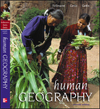
|  |
What's NewNew to the 7th EditionA great deal of new or expanded text has been incorporated in this seventh edition of Human Geography, including revised considerations of how maps show data and fundamentals of GIS in Chapter 1. Part I benefits from new material on stimulus diffusion; globalization and cultural convergence; gender and migration; and the population impact of AIDS. Part II revisions and additions include immigrant language contributions, migration and ethnicity impacts, and changing national and world demographic patterns. Part III incorporates new or reconsidered treatments of the intensification of agriculture and the green revolution; changing trends in world trade flows; post-Fordist, just-in-time, and flexible manufacturing processes; world industrial patterns; and tourism as a tertiary activity, while major revisions of central elements of the urban and political geography chapters help restructure Part IV. These and many other text changes are supplemented by totally new or extensively revised and updated content and "public policy" boxed discussions in all chapters and by more than a score of new and revised maps and graphs and updated tables and statistics.Here is a list of the specific changes that have been made to this edition:Chapter 1
- New "On-Line"
- Expanded box on "Careers in Geography"
- Addition of material on GIS
- Totally revised discussion and new line art on topic "How Maps Show Data."
Chapter 2- New "On-Line"
- Expansion of "diffusion" discussion to include "stimulus diffusion."
- Introduction of "globalization" in culture and cultural convergence discussions
Chapter 3- New "On-Line"
- Revised and updated figures
- New box "Gender and Migration"
- Text revision, "Public Policy" box revision, and updates of data as necessary
Chapter 4- New "On-Line"
- Updating of all population figures and projections using current US Census, U.N., World Bank, and Population Reference Bureau data.
- Extensive text revisions reflecting new assessments of national and international population trends, including morbidity and mortality data
- New, extended discussions of HIV/AID occurrence and its population implications.
- Moderate to major revisions and updating of all boxed discussions.
Eighteen new or revised line art pieces, including new versions of essentially all of the chapter's world maps
Chapter 5- New "On-Line"
- Expanded treatment of immigrant speech contributions to US English
- Selective expansion and refinement of discussions of principal religions, particularly Judaism and Islam.
Chapter 6- New "On-Line"
- New, expanded "Matter of Race" box
- Updated immigration and ethnic mix figures for all cited countries
Chapter 7- New "On-Line"
- Expanded coverage of popular culture
- Revision of folk housing and architectural hearth areas
Chapter 8- New "On-Line"
- New Box: "A Costly Habit" (US petroleum supply and consumption)
- Expansion and revision of section on "Intensification and the Green Revolution"
- Extensive revision and expansion of "Trade in Primary Products" section
- Four new or revised figures
Chapter 9- New "On-Line"
- As needed, revised and updated graphs and maps
- Extensive text changes to the "Locational Decisions in Manufacturing" segment, including revisions of sections on: "Principles of Location," "Labor," "Transportation and Location," and "Industrial Location Theories."
- New material on "Fordism," just-in-time, and flexible manufacturing processes
- Updated "Transnational Corporation" discussion
- Revised and consolidated "World Manufacturing Patterns" section
- Updating of text and tables in "High-tech" and "Tertiary and Beyond" segments, including a brief addition on "Tourism" as a special aspect of tertiary activities
Chapter 10- New "On-Line"
- Factual and interpretative updating of text, tables, and maps throughout, particularly in the extensive "Economic Measures of Development" segment
- Lesser but needed revisions in "Non-Economic Measures" portion of the chapter
- Some reduction in the number of world maps to lessen data overload for students
- Totally rewritten boxes on the topics of "Poverty and Development" and "Does Foreign Aid Help?"
Chapter 11- New "On-Line"
- Numerous minor text changes to update facts and clarify and simplify the topical discussions
- Extensively revised "Central City Change" section with near-total revision of the "Expanding Central City" discussion
- New box discussions: "Birds of a Feather," examining Zip code socioeconomic segregation of Americans; and "Dichotomous Metropolitan Region" contrasting U.S. central cities and suburbs
Chapter 12- New "On-Line"
- Text changes to reflect changing domestic and international political conditions
- Updated "Legislative Women" box
- New segment on "Supranationalism" and a revised and broadened discussion of international economic alliances
- Deletion of the chapter-ending segment on "Unified Government" (of metropolitan areas)
Chapter 13- New "On-Line"
- Some text revisions to summarize and review latest "global warming" observations
- Update of "Climate Change Summits" box
- Minor revisions of other sections (e.g., "Landfill Disposal")
|
|
|